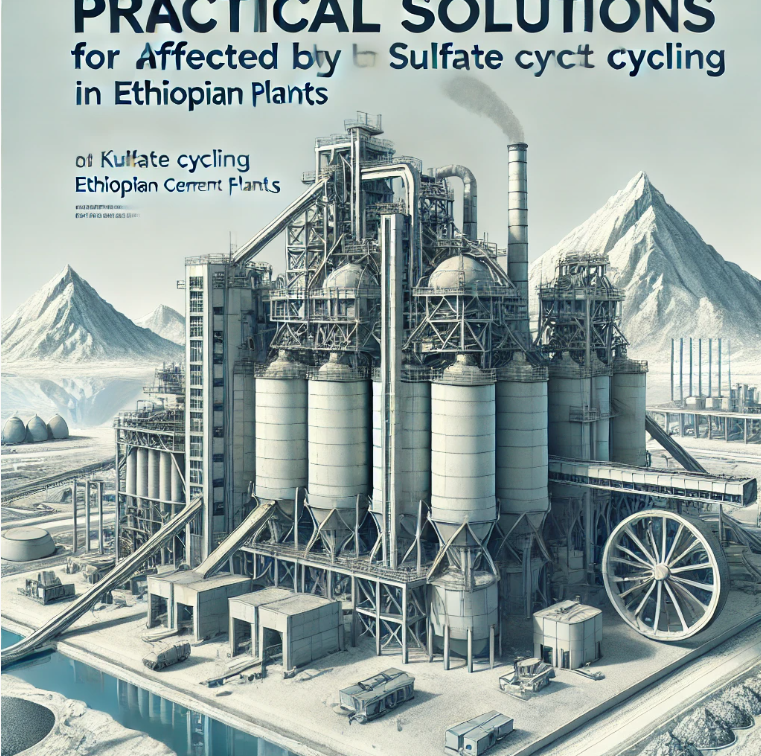Contents
Practical Solutions for Kilns Affected by Sulfate Cycling in Ethiopian Cement Plants

TO Download this post and all the books and excel sheets and my personal notes and presentations I collected about cement industry in the last 30 years click the below paypal link
Many Ethiopian cement plants are currently operating with a high ratio of locally sourced coal due to compelling circumstances. Unfortunately, the high sulfur content and low quality of this coal have led to significant operational challenges. These challenges include unwanted breakdowns, reduced production, and equipment damage due to the formation of sulfur rings. To address these issues, I am sharing practical solutions that could help mitigate the effects of sulfate cycling in kilns:
1. Use of Raw Materials
One of the most effective solutions is opting for raw materials with a lower sulfate content and a higher alkali content. This helps in establishing a molar balance between sulfates and alkalis, which is crucial for reducing the formation of sulfur rings and minimizing disruptions in kiln operations.
2. Feed Softening
A softer feed can facilitate quicker and easier chemical reactions, which in turn reduces fuel requirements. Lower fuel consumption leads to less evaporation of sulfates and other volatile materials, allowing more volatiles to be expelled along with the clinker. This minimizes the buildup of sulfur within the kiln system.
3. Oxygen Levels
In kilns affected by sulfate cycling, maintaining proper oxygen levels is critical. While typical oxygen input should range between 1.5% to 2%, a kiln prone to sulfate cycling requires more than 2% oxygen input. This helps prevent reducing conditions that could increase sulfate evaporation. Simply maintaining 1.5%-2% oxygen at the kiln inlet is not sufficient to ensure adequate oxygen supply throughout the kiln.
4. Burner Positioning
It’s important to ensure that the burner tip is properly centered in the kiln. If the burner is angled downward, the flame may come into contact with the kiln charge, creating reducing conditions that increase sulfate volatility. Proper burner alignment minimizes this risk and promotes stable operations.
5. Burner Insertion
Inserting the burner deeper into the kiln allows for improved air-fuel mixing, which helps in reducing the likelihood of reducing conditions around the flame. This adjustment can also prevent the over-evaporation of sulfates, thereby limiting the formation of sulfur rings.
6. Avoid Long Flames
Long flames can extend the heating zone within the kiln, giving sulfates and other volatile compounds more time to evaporate due to prolonged exposure to high temperatures. By avoiding long flames, the kiln’s heating zones can be more efficiently controlled, reducing the potential for excessive sulfate evaporation.
7. Increased Rotation Speed
Increasing the rotation speed of the kiln reduces the residence time of materials within the kiln. This limits the amount of time sulfates and other volatiles have to evaporate, thus minimizing their buildup and the formation of sulfur rings.
Conclusion
By implementing these practical solutions, Ethiopian cement plants can mitigate the adverse effects of sulfate cycling, improve their operational efficiency, and reduce downtime caused by sulfur-related issues. Ensuring the right balance of raw materials, optimizing kiln oxygen levels, adjusting burner positioning, and controlling kiln rotation speed are essential strategies to maintain stable production.
References
- Cement Professional Group
- Ethiopian Minerals
- Ethiopian Ministry of Industry (የኢፌዴሪ ኢንዱስትሪ ሚኒስቴር)
- Ministry of Innovation and Technology, Ethiopia
- Ethiopian Ministry of Trade and Regional Integration
- Ethiopian Engineering Corporation
- Queensland Coal Exploration Pty Ltd.
Companies Mentioned
- Messebo Cement
- Mugher Cement Enterprise
- LEMI National Cement PLC
- Habesha Cement Share Company
- Derba MIDROC Cement Private Limited Company
This post offers practical insights for addressing sulfate cycling challenges in cement kilns, helping Ethiopian cement plants improve their operations and equipment reliability.
TO Download this post and all the books and excel sheets and my personal notes and presentations I collected about cement industry in the last 30 years click the below paypal link
